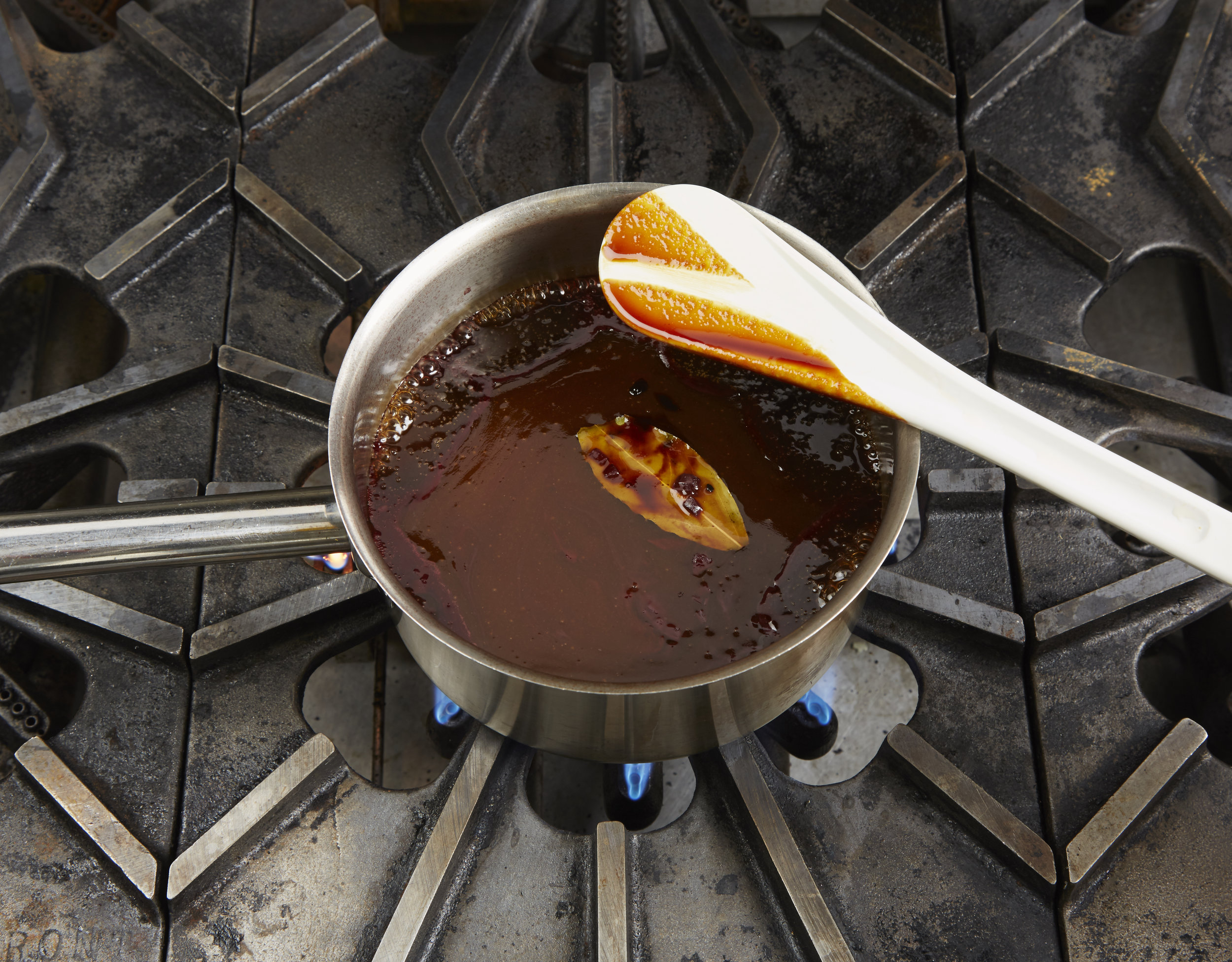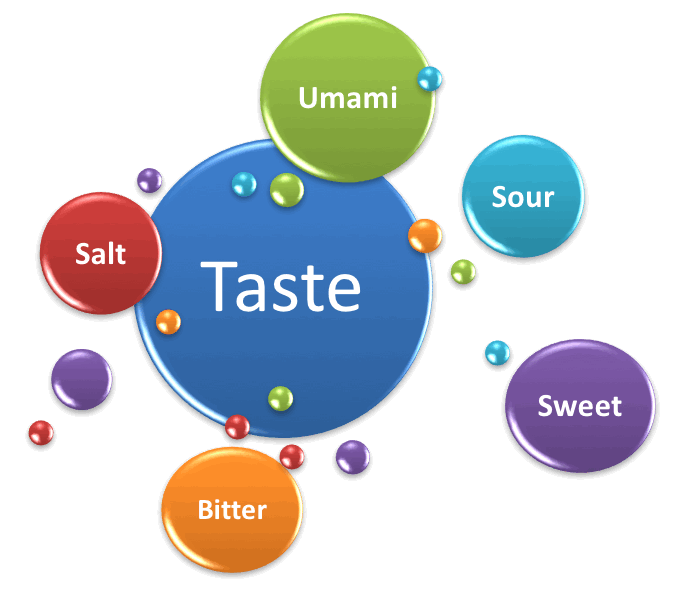The Principles of Sauce Making
Sauces add flavor, texture, moistness, viscosity, and eye appeal to a dish. They help pull together the various elements of a plate and make it whole. Sauces also add contrasting or complementary flavors and colors to a plate, keeping the dish exciting and appealing throughout the dining experience.
Sauce Variations
Sauces are the melding of ingredients, including stocks, wine, aromatics, herbs, and dairy, into a harmonious taste. Most small sauces are based on the principle of reduction, cooking down various liquids with aromatics, wine, and herbs to meld, concentrate, and balance the flavor and consistency. This method creates a simple jus by deglazing the pan from a roast and enhancing its flavor with aromatic vegetables, stock, and seasoning.
Deglazing a pan to create a pan sauce
A pan sauce is created similarly when a sautéed protein produces caramelized bits that cling to the pan and the juices rendered from the cooked items, whether they are meat, poultry, or fish. The sauce is completed with reduced wine and aromatics (shallots, mushrooms, garlic, etc.) and finished with whole butter or cream.
French Grande Sauces (also known as mother sauces), including espagnole, béchamel, and velouté, are roux-based sauces prepared with stock or milk as their liquid. These sauces incorporate aromatics, including onions, celery, and carrots (depending on the sauce) that are sautéed to a translucent stage or browned further for color and flavor. A sachet d’epice is added for seasoning. They are not salted but seasoned when incorporated into other preparations. Secondary sauces are derived from a mother sauce, which includes a demi-glace, Allemande, or supreme. These sauces are further reduced with added cream, stock, wine, or aromatic ingredients.
Classic French Mother Sauces
From the grande and secondary sauces, small sauces or derivatives, along with pan sauces, are prepared by incorporating any combination of ingredients. Most small sauces are based on reducing or cooking down various liquids with aromatics, wine, and herbs to meld, concentrate, and balance the flavor.
PrActical Sauce Prep in the Kitchen
Sauce making begins with a flavor base of aromatics, reductions of wine, vinegar, or other spirits, the addition of flavorful liquids, including stocks, milk, or cream, and various seasonings. Others are created through emulsions of fats with liquids and eggs or through pureed suspensions of cooked aromatics, liquids, and seasonings.
Start with a Flavor Base
Begin by sautéing or sweating (gently cooking in fat) an aromatic flavor base of vegetables (shallot and garlic, mirepoix, or soffritto) in butter, olive oil, or another type of fat. This releases their flavors and infuses them into the sauce as it cooks.
Develop Consistency
Flour can be added at this stage (known as the singer method) or thickened later with a prepared roux, refined starch, or other thickening agent. Some preparations are thickened by suspensions, such as tomato sauces, and need no added starch. Still others, including meat-based jus, may be left unthickened, relying on reduction to concentrate flavors while gelatin from the meats adds body.
Add Liquids, Season, and Simmer
Stock, milk, wine, or other liquids are added, and the sauce is simmered. If a prepared roux is used, it is added at this stage. A sachet d’epice or bouquet garni is added to flavor the sauce. The sauce is simmered and reduced in volume for the appropriate time to develop flavor and consistency.
Skim the Sauce
Cleaning a sauce is critical in creating a clear sauce, a French term known as depouillage. Bring the sauce to a simmer and offset the pot on the burner so that, as the scum rises to the top, it rolls to one side of the pot and makes it easier to skim off the impurities. Repeat skimming throughout the sauce process.
Strain/Puree
Sauces may be pureed in a food mill or blender and strained through a fine mesh strainer. If a refined starch is used (instead of a roux), the sauce is re-heated, and a slurry is added to thicken the sauce.
Evaluate and Adjust Consistency and Texture
A sauce should have a light yet thick consistency to coat the back of a spoon. Chefs use the French term nappé, meaning to top or coat with sauce, to describe the proper consistency. If the consistency of a sauce is too thin or the flavor too weak, adjust it by gently simmering the sauce to reduce, thicken, and concentrate the flavors. Other alternatives include adding a thickening agent, cream, a swirl of butter, or a liaison of egg yolk and cream. Add water, stock, or other liquid to adjust consistency if the sauce is too thick.
Small & Derivative Sauces
Flavor Base - Small sauces and pan sauces use aromatics of sautéed shallots, garlic, or mushrooms. Some techniques combine the aromatics with wine or spirits and cook down the liquid to concentrate the flavors. Spices and herbs are added to the reduction as it is cooking, but fresh herbs are usually added at the end to preserve their fresh color and flavor. Gastrique sauces start with a base of caramelized sugar deglazed with wine, vinegar, or citrus juices to create a sweet and sour flavor profile.
Reduction of Wine, Aromatics, and Herbs
Deglaze & Reduce - When preparing a pan sauce for a sautéed item, use the pan in which the item was sautéed, and add the garnish ingredients to the pan. The pan is then deglazed with wine, brandy, or other spirits, and the liquid is reduced, or cooked down, by ¾ volume or au sec, a French term for almost completely dry. Depending on the production volume, this may take a short period, as in a pan sauce, or it may take much longer for a larger quantity.
Grande Sauce - A prepared sauce of demi-glace, jus lié, or velouté is added at this stage. A highly concentrated stock can be used as a substitute. It is cooked again to adjust the flavors, seasonings, and consistency. Sometimes, the consistency requires adjustment with a slurry of refined starch.
Addition of a Brown Sauce
Additional Flavors—Fortified wines such as sherry, port, and Madeira are often added towards the end of the cooking process because their flavors dissipate under prolonged heat. Fresh herbs are also added at this stage. Again, the consistency, seasonings, and flavors should be evaluated to determine whether further adjustments are needed.
Monter au Beurre—Finishing a sauce with a little butter, cream, or yogurt enriches it, smoothing out the acidity and providing a sheen. When using stock instead of a prepared sauce as the base, the addition of butter or cream helps thicken it.
Monter au Beurre
Taste, Evaluate & Adjust
Taste
To balance the flavor and seasoning of your sauces, consider all the basic taste sensations
Salt is the most primal taste and reduces bitterness
Bitterness is derived from herbs and spices, including tarragon, sage, and peppercorn
Sweet is added with the addition of sugar, butter, and cream
Butter also adds a savory sensation
Acidity lifts and lightens the sauce's flavor on the tongue; adding a little vinegar, wine, or lemon can do the trick.
Umami is the savory taste in meats, poultry, fish, cheese, tomatoes, and mushrooms.
Consistency & Texture
Thin sauces release aromas that are more immediately noticed by the sense of smell.
Thickening agents obstruct the flavor of a sauce, requiring more salt and seasoning.
Thickened sauces tend to linger on the tongue longer and prolong the flavor better than thin sauces.
Too Thin? If a sauce's consistency is too thin or too weak, it can be adjusted by reducing it on the stove. Other alternatives include adding more thickening agents, cream, a swirl of butter, or a liaison of egg yolk and cream.
Too Thick? - If it is too thick, it can be thinned with a little water, stock, or other liquid. Be careful to taste and adjust the seasoning. Thinning with water will dilute the flavor, so it usually is not recommended except when it is too intense. Sauces in a steam table will evaporate over time, becoming too thick or salty; in this situation, it may be appropriate to adjust with water.
Holding Sauces for Service
If the sauce is prepared in advance and held for service, a skin may form on its surface. Here are a few ways to prevent this.
Butter - A little butter swirled on the surface will help prevent this. When using this technique, the sauce may appear greasy as it sits. The proper method for ladling the sauce out is not to stir it. Instead, dip the ladle directly into the sauce and lift the ladle straight up to minimize the amount of butter on the surface of the sauce.
Parchment Paper—Make a cartouche of “false lid” out of parchment, butter it, and place it directly on the surface of the sauce.
Plastic Wrap - Other methods for preventing a skin include placing plastic wrap or parchment paper directly on the surface of the sauce so no air gap is present to dry out the surface.










